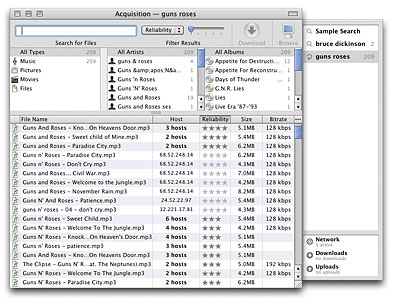If you are also gathering a live acquisition of the computer, proceed to the steps in the tutorial for Live Acquisition of Mac Computers, which can be found HERE. As a point of reference, the RAM collection performed above, was on a MacBook Pro with Retina Display (mid 2012) with a 2.6 GHz Intel Core i7. Download AxoGraph Installer for Windows XP and up. Download AxoGraph Installer for Mac OS X 10.4 to 10.14. Note: AxoGraph is a 32-bit app and can't run directly under MacOS 10.15 Catalina. However, a work-around is available, and a 64-bit version of AxoGraph is under development. Security Update 2021-004 (Catalina) macOS Catalina Security Update 2021-004 (19H1323) is recommended for all users and improves the security of macOS.
Download RockMelt 2.2.0 for Mac. Fast downloads of the latest free software! Acquisition for Mac, free and safe download. Acquisition latest version: Innovative Mac P2P client. Download Acquisition Pro. Are totally free with this option. You'll be set for life! Mac OS X Leopard Required — Activation Code Redelivery — FAQ. Download the latest version of Acquisition for Mac - Gnutella file-sharing client. Read 746 user reviews of Acquisition on MacUpdate.
You can download ReFX Nexus v2.2 Free by accessing the link below. Also, make sure that you have enough back up before you proceed with the same. There are a lot of duplicate ISO images on the market and it is best to download the same from a trusted source. Download ReFX Nexus v2.2 full version for free - ISORIVER.
SONAR Mac Prototype
A collaboration between Cakewalk and CodeWeavers
Several months ago, we promised to deliver a SONAR Mac Alpha. To build it, we collaborated with a company called CodeWeavers. CodeWeavers has a technology called CrossOver that is basically a Windows-to-Mac translator, allowing native Windows applications to run on a Mac.
Together, Cakewalk and CodeWeavers used CrossOver to enable a native Windows version of SONAR Home Studio to run on a Mac. We've packaged this product for release as a SONAR Mac Prototype, available now as a FREE download to all who are interested.
Learn more about our journey on the Cakewalk Blog.
Now turn your musical dreams into as real as it can get with a next-generation ROM synthesizer of the highest quality by Nexus called ReFX Nexus v2.2. One needs to give up on the traditional devices which are now boring, stale, stereotypical and old sounding ROM synthesizer and give a chance to the latest version of NEXUS2 as one should embrace the power and evolve your productions and those musical dreams to the next level of greatness you can ever experience with a device.
Acquisition Download For Mac Pro
The latest NEXUS2 comes to you with ultra-fat, contemporary sound storms, new sonic territory delivering complex, that sounds exactly like the most expensive hardware you can explore that is available in the market today.
License
Trialware
File Size
3.18GB
Language
English
Developer
reFX Audio Software Inc.
Overview of ReFX Nexus v2.2
ReFX Nexus v2.2 comes with a flexible and powerful foundation base. These characteristics of ReFX Nexus v2.2 support the design of the device which is spontaneously engaging and immediately useful for the user. The ReFX Nexus v2.2 was built keeping in mind to aim to produce music quickly with the highest quality and causing as little fuss it can as possible.

Here's a world-class 32 step arpeggiator that is been featured by ReFX Nexus v2.2 which comes with astonishing characteristics and features like industry leading reverb licensed from Arts Acoustic, an agile and simple 32 step trance gate, sophisticated modulation-matrix that will help you sculpt the sound as per your wish smoothly.
Java 1.6 download 64 bit mac. Recommended Post:-Download Open Broadcaster Software 2020 for free
Features of ReFX Nexus v2.2
Sequencer
There can be no difference between the chord that you hear somewhere and want to put it down as it is. NEXUS2 sequencer is easy to use and is intuitive one needs to try. There are 20 modulation slots out of which four are macro controls quick access modulators
The Arpeggiator
As it is well known to us all that the dance music would hardly come into existence without those magical arpeggios bouncing around your head even after weeks and days after hearing one particular track at the club or restaurant or on TV. So there is no compromise being made on the ReFX Nexus v2.2 redesigned Arpeggiator. It has got a sequencer which is 32-step, note, and octave transposition, and the most important adjustable loop start position are some of the features that one would want to have control of and can go deep into them as one build ups the tracks.
Late in 2012, the only free solution for Mac memory acquisition was MacMemoryReader, which is not open source and depends on a binary distribution of the driver to be built especially for the target kernel. This means MacMemoryReader actually carries 5 different versions of it's kernel extension in it's supportfiles directory, and automatically chooses the correct one as long as it is used on a system that was supported at the time the program got packaged.These constraints didn't fit our use case very well, which is why I developed an open source memory acquisition program for Mac OSX called OSXPmem. This program was designed specifically with the goal to be as operating system independent as possible, while providing a stable way to acquire memory even on future versions of Mac OSX.
With the 10.9 release of OSX, MacMemoryReader stopped working (it only packages drivers for OSX 10.5 - 10.8). Fortunately, OSXPmem still works and is currently the only free memory acquisition tool which is able to acquire memory on Mac OSX 10.9 or higher.
In this blogpost I want to elaborate a bit on the reasons for that, while also giving an overview on how memory acquisition on Mac OSX actually works under the hood.
How Memory Acquisition is Implemented
The bottom line is that a memory acquisition tool must find out how physical memory is laid out in order to acquire it in a way that does not cause instability and thus loss of the desired data. This is usually done by querying the kernel, as it manages physical memory and has to know it's layout. On Mac OSX the EFI passes this information to the component of the kernel called the platform expert, which stores it in a KPI (where the Platform Experts state is linked from). But even supported KPIs like the ones for physical memory mapping can change, as Apple has shown in the past.
Download Chrome For Mac
| Figure 1: PTE Remapping |
By 'bypassing' the kernel when accessing memory this technique does not depend on any KPIs and thus isn't affected by compressed RAM or any obstacles Apple might decide to put into the IOMemoryDescriptor in future versions of OSX. This is why we made it the default mapping method in WinPmem and OSXPmem. We expect this method to be more stable and resilient to changes in the kernel and even anti-forensic techniques.
